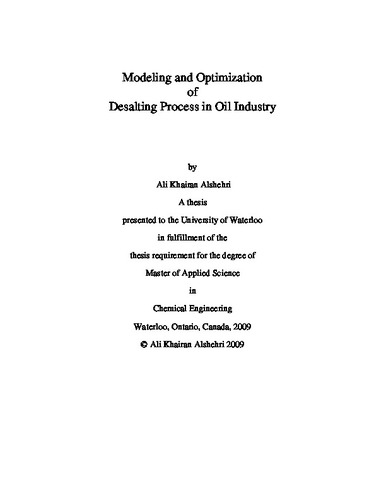| dc.description.abstract | Throughout a very long piping network crude oil in Saudi Arabia is sent to Gas Oil Separation
Plant called GOSP. The main objectives of the GOSP are:
- Separation of the associated gas through pressure drop in two series stages one to 120
psig and the other to 50 psig.
- Separation of water by gravity separators called High Pressure Production Trap (HPPT),
Dehydrator, Desalter and Water Oil Separator (WOSEP).
- Reducing salt concentration to less than 10 PTB utilizing wash water and demulsifier.
During the desalting process, the challenge is to overcome the existence of an emulsion layer at
the interface between oil and water. In petroleum industry normally emulsions encountered are
some kind of water droplets dispersed in a continuous phase of oil. In crude oil emulsions,
emulsifying agents are present at the oil-water interface, hindering this coalescence process.
Such agents include scale and clay particles, added chemicals or indigenous crude oil
components like asphaltenes, resins, waxes and naphthenic acids.
Many techniques made available to gas oil separation plant operators to minimize the effect of
tight emulsions. These techniques include injection of demulsifier, increasing oil temperature,
gravity separation in large vessels with high retention time as well as electrostatic voltage. From
experience and studies these variables have been already optimized to a good extent; however,
from the believe that knowledge never stop, this study is conducted targeting enhancing the
demulsifier control and optimizing the wash water rate.
The objective of this study is to design an Artificial Neural Network (ANN) trained on data set
to cover wide operating range of all parameters effecting demulsifier dosage. This network will
be used to work as a control black box inside the controller in which all effecting parameters are
inputs and the demulsifier dosage is the controller output. Testing this control scheme showed an
effective reduction in demulsifier consumption rate compared to the existing linear method.
Results also, showed that the existing control strategy is highly conservative to prevent the salt
from exceeding the limit. The generated function from the ANN was used also to optimize the
amount of fresh water added to wash the salty crude oil. Finally, another ANN was developed to
generate an online estimate of the salt content in the produced oil. | en |

